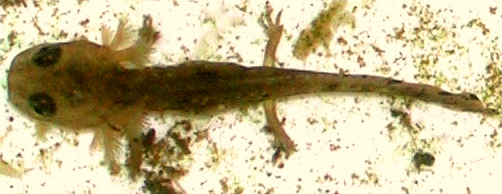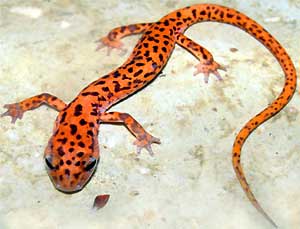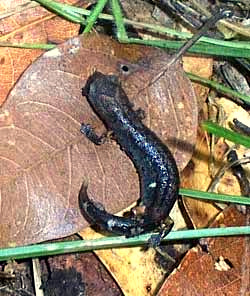Salamanders and their kin are secretive, voiceless, and usually nocturnal. The most obvious differences between them and lizards is that they lack scales on their skin, bear no claws, and have no external ear openings. Both adults and their immature larval stages are carnivorous. Most salamanders lay their eggs in water. Salamander larvae hatching in water bear external gills which are lost as they metamorphose into adults. The larvae of species that lay eggs on land do not have an aquatic stage, and look like miniature editions of the adults.

The chance of seeing salamanders, newts and their kin is diminishing fast. The IUCN -- the International Union for Conservation of Nature -- classifies around half of all the world's salamander species as Threatened. Habitat destruction, roadkill, water pollution and wetland draining are the big threats. There's more information at the Save The Salamanders website.
CLASSIFICATION
In order to put salamanders and newts in a general context within the world of amphibians, here is a simplified breakdown for the most commonly encountered groups in North America:
CLASS: Amphibia (Amphibians)
- ORDER: Caudata (tailed amphibians)
- FAMILY: Plethodontidae (Lungless Salamanders)
- FAMILY: Ambystoma (Mole Salamanders)
- FAMILY: Salamandridae (Newts)
- FAMILY: Cryptobranchidae (Hellbenders)
- FAMILY: Sirenidae (Sirens)
- FAMILY: Proteidae (Mudpuppies)
- FAMILY: Amphiuma (Amphiumas)
Here are characteristics of each of the above families:
- Lungless Salamander Family (Plethodontidae) -- largest, most commonly encountered family, with about 80 species in North America north of Mexico. Being lungless, they breathe through their slimy skin. The Cave Salamander shown below is a typical member of this family
- Mole Salamander Family (Ambystomidae) -- like the above, but more thick-bodied; maybe the best-known one is the Tiger Salamander
- Newt Family (Salamandridae) -- like salamanders but skin not slimy and rather rough; that's a newt atop this page
- Hellbender Family (Cryptobranchidae) -- restricted to clear, fast-flowing streams and rivers with rocky bottoms
- Siren Family (Sirenidae) -- eel-like, very small fore limbs and no hind limbs; retain gills as adults (they're "neotenic")
- Mudpuppy & Waterdog Family (Proteidae) -- also neotenic, the adults bear red, plumelike gills, 4 toes on both front and hind feet, and flattened tails
- Amphiuma Family (Amphiumidae) -- aquatic, eel-like, with 4 tiny, useless limbs, each with 1-3 toes


 Though salamanders and their kin are unlikely to occur in our backyards, they are worth looking for when we visit more natural places. Many species are colorful and all are interesting to know about. Because they are so threatened by human environmental abuse, it's especially important for us know and care about them.
Though salamanders and their kin are unlikely to occur in our backyards, they are worth looking for when we visit more natural places. Many species are colorful and all are interesting to know about. Because they are so threatened by human environmental abuse, it's especially important for us know and care about them.
And if you look hard enough, some day you're bound to find something like the Red-legged False-brook Salamander, Pseudoeurycea cephalica ssp. rubrimembris seen at the right, and photographed on a camping trip in the upland piney woods of central Mexico. This species is described as threatened by habitat destruction.
